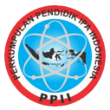Empirical Validation of Static Electricity Animation Videos to Improve the Cognitive Abilities of Physics Science in Junior High School Students
Abstract
This research aimed to determine the perceptions of students and teachers and describe the cognitive abilities of students after learning using static electricity animation videos. The research sample consisted of 31 students of class IX-6 who were randomly selected. The researcher gave a questionnaire sheet that had been validated by experts as a research instrument in collecting teacher and student responses regarding the practicality of the media with 10 indicators of practicality and gave 20 post-test questions which were analyzed descriptively. The results showed that based on teacher responses obtained an average of 3.7, student responses obtained an average level of media practicality of 3.5 with a very high category and the results showed that students' cognitive abilities obtained an average of 82.2 with a good category. The results of teacher and student responses as well as practicality test results concluded that animated video-based learning media on static electricity material was effective and practical to use as learning media for Class IX Junior High School students.
References
Arianda, N., Anhar, A., & Syamsurizal, S. (2018). The Effects of discovery learning model nuanced science literacy towards students’ competence in learning natural science. International Journal Progressive and Technologies (IJIPSAT), 8(1), 96-105.
Hardianti, T. (2018). Analysis of students' abilities in the cognitive domain when learning high school physics. In Quantum: National Seminar on Physics and Physics Education (pp. 557-561).
Kuntjojo, K., Wijaya, I. P., Lailiyah, N., & Wulansari, W. (2017). Scientific writing training for kindergarten teachers in Kediri District.
Kusumaningrum, M. E., Siswanto, J., & Roshayanti, F. (2021). Patterns of cognitive ability and creative thinking on the concept of environmental change among male and female students at SMA Negeri 2 Mranggen. INKUIRI: Journal of Science Education, 9(2), 138-146.
Nisyak, K., Syafii, M., & Zulirfan. (2021). Development of animated video learning media using Animaker application as an effort to improve the cognitive ability of junior high school students on static electricity material. JOM FKIP-UR, 8(2).
Priyadi, R., Mustajab, A., Tatsar, M. Z., & Kusairi, S. (2018). Analysis of critical thinking skills of class X MIPA students in physics learning. JPFT (Journal of Physics Education Tadulako Online), 6(1), 53-55.
Rahman, A., Herlina, L., Leksono, S.M., Dewi, R., & Nurul Rahmah Kusumaputri, N.R. (2020). Metode pembelajaran student created case studies (SCCS) terhadap peningkatan hasil belajar siswa SMAN Satu Baros. Diklabio: Jurnal Pendidikan dan Pembelajaran Biologi 4(2), 113-120.
Rahmayanti, D., & Jaya, P. (2020). The effect of canva learning media application with a scientific approach on basic learning outcomes of electricity and electronics. Voteteknika (Professional electronic engineering and computer science), 8(4), 107-113.
Rochman, S., & Hartoyo, Z. (2018). Analisis high order thinking skills (HOTS) taksonomi menganalisis permasalahan fisika. SPEJ (Science and Physics Education Journal), 1(2), 78-88. DOI: https://doi.org/10.31539/spej.v1i2.268
Sari, R.J. (2020). The implementation of scientific approach using video in teaching writing transactional text. IKIP Siliwangi.
Sugiyono. (2015). Metode penelitian & pengembangan research and development. Alfabeta.
Susanti, R. (2014). Powerpoint-supported model of learning examples without examples to improve science learning outcomes. Indonesian Journal of Science Education, 3(2).
Tanjung, R. E., & Faiza, D. (2019). Canva as a learning medium in basic electrical and electronics subjects. Voteteknika (Vocational electronic engineering and computer science), 7(2), 79-85.
Titiyanti, Y., Anam, S., & Retnaningdyah, P. (2022). Implementing canva in the digital learning process for Junior High School. Jurnal Education and Development Institut Pendidikan Tapanuli Selatan, 10 (3), 708-712
Yanto, D. T. P., Candra, O., Dewi, C., Hastuti, H., & Zaswita, H. (2022). Electric drive training kit as an innovative product for practical learning media for vocational education students: Practicality test analysis. JINoP (Journal of Learning Innovation), 8(1), 106-120.
Yustian, A. F. (2014). Implementation of product-oriented las skills learning using the demonstration method in first-high school students (junior high school). Doctoral dissertation, University of Education Indonesia.
Downloads
Published
Versions
- 2023-12-06 (2)
- 2023-12-07 (1)












